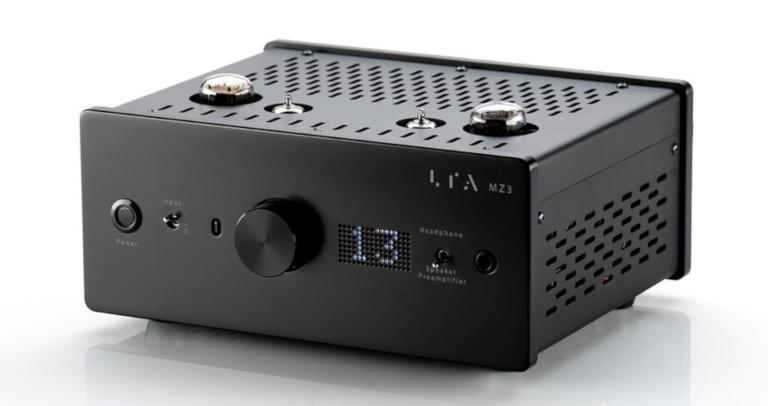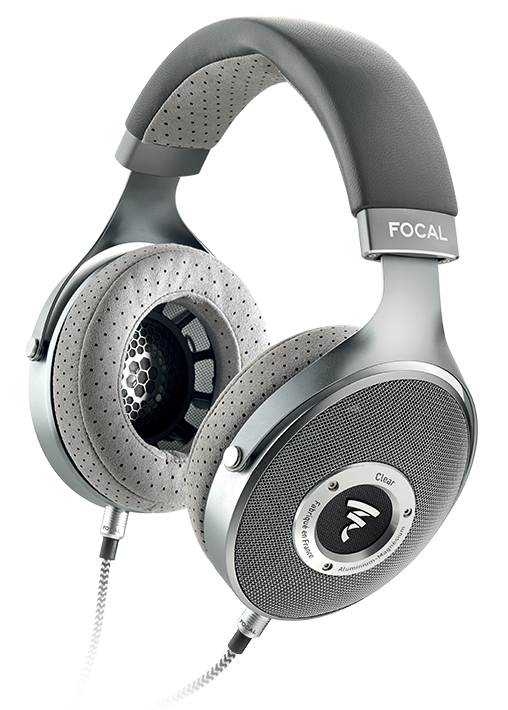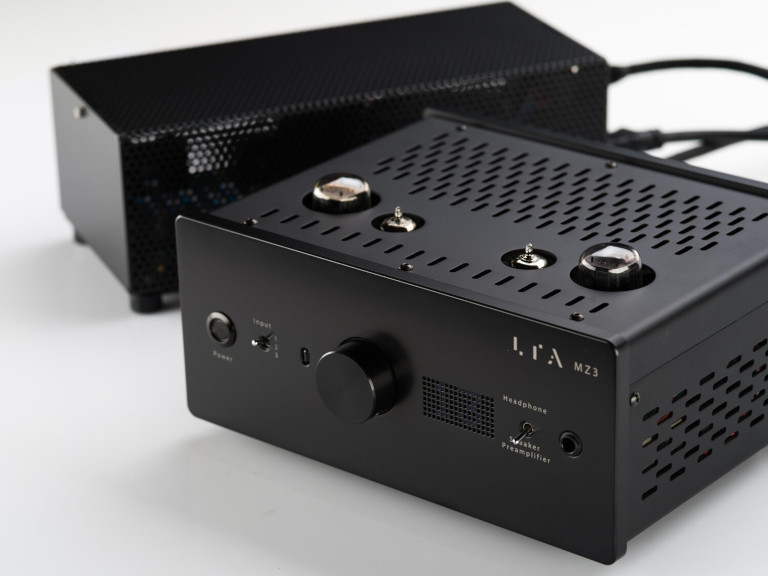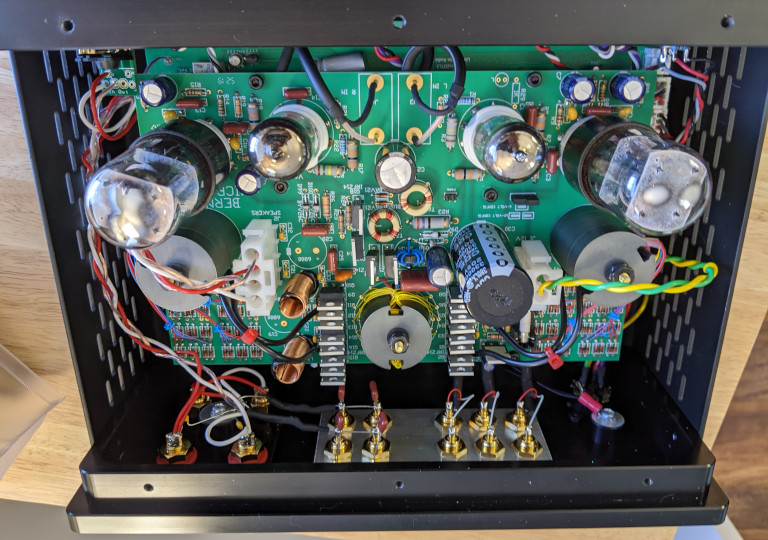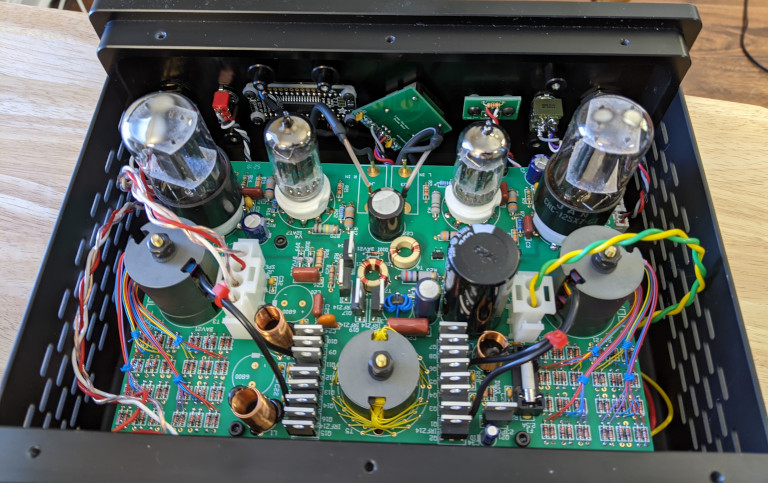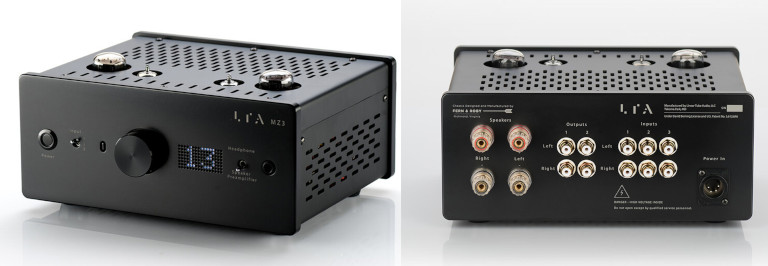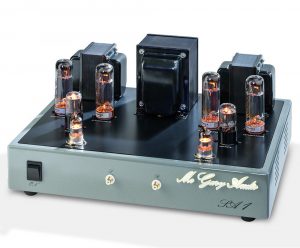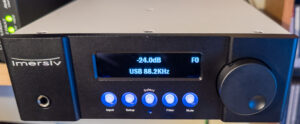Linear Tube Audio has a delicious solution for our headphone amplifier needs—the microZOTL MZ3. We love it! Let me tell you why it now has a well-deserved home in Ann's study.
Prologue… I've written previously about our journey into headphone-only audio as the result of our retirement, downsizing, and move into apartment living. We found the solution that suited us for our primary audio system, but there's also this second system that lives in Ann's study. It's her refuge, a place she can spend quiet time not bothered by me. I wanted to set her up so she had access to our music library, but be completely independent otherwise. That suited her just fine. A separate USB DAC fed by JRiver on her Microsoft Surface Pro tablet was easy enough to outfit. The challenge was the choice of headphones and how to drive them.
We thought at first that our 45-year-old Stax MR-X Mk.3 headphones and little Stax tube amplifier would be the solution. But, the amplifier needed work. A persistent hum in both channels was not going to be acceptable. And neither of us wanted to invest money to get it repaired. Too many unknowns—it might prove to be a bottomless pit for work, parts, and money. And parts availability was very "iffy" to say the least. So it became a gift to a Stax aficionado who was interested in rehabbing it.
New headphones should be pretty straight forward, right? Get dynamic headphones that are easy to drive and able to be powered from just about any serviceable headphone jack. The DAC manufacturer says they invested effort in the built-in headphone output circuit; it has a nice 1/4" stereo jack. Just get the 'phones and plug 'em in, right?
Hmmm... Not so fast. Not so straight forward after all.
We purchased a nice pair of headphones that we'd heard in a friend's system, the Focal Clear headphones—mid-priced, good sound, easy to drive. We'd liked them in his system without spending a lot of time critically listening. He still highly recommended them, and he is a friend "in whose ears we trust."
And so the headphones arrived, Ann plugged them into the DAC's headphone jack for a listening session… Annnndddd, they needed burn-in thought she. A week and lots of music playing time later, and… No.
Burn-in should be largely done, and on popular music things sounded pretty okay. Not great, but serviceable. Then she listened to some classical orchestral music. No, no way. Not going to be acceptable. The combination just did not offer sufficient resolution and clarity for orchestral music listening. Talk about one very disappointed puppy—it was heart-breaking to observe.
So, what's going on here?
Yes, all of you reading this know the answer. The DAC's headphone circuit just wasn't cutting it. At least that answer became my top suspect. We needed to get for her a separate headphone amplifier that would nicely drive those headphones.
And here enters Linear Tube Audio... I've known about Linear Tube Audio (LTA) since their founding by Mark Schneider in 2015. Their office and manufacturing site are in the Maryland suburbs of Washington, DC. When we lived in Richmond, VA, this was close enough to be backyard territory. And their products have a very positive reputation for good design and high quality construction.
More significantly, LTA manufactures tube gear using David Berning's ZOTL (Zero hysteresis Output Transformer-Less) architecture. About which I'll have more to say in a moment.
We've been big fans of output transformerless amplifier designs. For many years we lived with Ralph Karsten's magnificent Atma-Sphere MA-2 OTL amplifiers, 200w monoblocks. We loved what these big OTL amps did for the quickness, clarity and transparency of the sound we enjoyed through our speakers. We'd also listened extensively to Ralph's seductive little S-30 OTL stereo amplifier, 30w per channel, in a friend's system. And we'd listened quite frequently to David Berning's ZH-270 stereo amplifier in another friend's system.
I'd say we were quite confidently aware of the sonic contributions OTL amplifiers can deliver: fast, neutral, transparent, harmonically accurate, and with extended frequency response. With traditional OTL amplifier designs you need to exercise some care in mating them with the proper load at the speaker end of the audio chain. They are happier with higher impedance loads when it comes to driving speakers, 8 ohms and higher is the general rule of thumb for Atma-Sphere OTLs, but models with greater numbers of output tubes (e.g., the MA-2 and MA-3) can handle down to 4 ohms as long as the impedance curve is fairly smooth and without dramatic dips and peaks.
The David Berning designs are a different matter entirely. Vigorous debate has ensued in the past about whether Berning's circuit is truly an output transformerless design in the classic sense (just do a bit of search). But there is no doubt in anyone's mind about this being a truly innovative design. And there is no traditional output transformer in the audio frequency. The source of debate comes from the device in the circuit that both Berning and LTA call an Impedance Converter used to match the impedance of the speaker. Some claimed that this clearly is a transformer, so Berning is careful to differentiate his design as a Zero-Hysteresis output transformerless circuit. It is transformer-core hysteresis that causes distortions in the audio band, and the Berning circuit eliminates this problem.
Linear Tube Audio offers the easiest to understand explanation of the ZOTL circuit that I've found:
"First, the audio signals 'ride' a carrier frequency, on which they are amplified by the tubes (it is not a hybrid amplification design), then the carrier is removed by the Impedance Converters and the remaining audio is delivered to the speaker, similar to how a radio station and receiver work. This changes the impedance plane to match the impedance of the speaker, so the audio output transformer is no longer required to match the tube to the speaker. An Impedance Converter accomplishes this match up. This super linear amplification process allows the amplifier to have a flat frequency response from 8Hz to 50kHz, which is nearly impossible with an output transformer…ZOTL technology involves a linear amplification process using a carrier frequency as well as not having a traditional audio output transformer, instead using air-core Impedance Converters. "
(See Linear Tube Audio, ZOTL Technology)
Originally developed by David Berning in 1996 and patented in 1997, the ZOTL circuit was radically different from anything around at the time. It is still radically different. Even though Berning ceased production of his amplifiers some years ago, they regularly are applauded as a standard of excellence in amplifier design and service and parts continue to be available directly from David Berning.
With Berning no longer producing his own amplifiers, Linear Tube Audio's founder, Mark Schneider, developed a remarkable relationship with Berning. Schneider founded Linear Tube Audio in 2015 following an extensive engineering career in manufacturing and product design – including being the architect behind the fastest document scanner in the world. As explained on the LTA site:
"Since the debut of ZOTL technology, no one else has been able to successfully manufacture David Berning’s complex designs. It was this uniqueness and complexity that attracted Mark to producing ZOTL amplifiers specifically, in addition to their spectacular sound. Each amplifier requires hours of hand-building, which is currently done by Mark and his team in LTA’s Washington, DC workshop. David Berning personally reviews initial units to ensure that the build quality meets his extremely high standards."
LTA's debut product coming from this collaboration was an improved version of David Berning’s original microZOTL—the microZOTL 2.0 (now identified as the microZOTL MZ2). Additional amplifiers based on the ZOTL circuit followed, with Schneider and Berning working collaboratively. Berning designs the core amplifier circuitry to Schneider’s specifications, and LTA creates the rest of the unit.
And the results being achieved are extremely good! I've listened to LTA's ZOTL10 MK.II amplifier and microZOTL reference preamplifier in a friend's system with great satisfaction. Very clean, very transparent, and highly resolving.
All of which aligns very nicely to what we sought for a sonic match to the Focal Clear dynamic headphones. We had reasonable confidence that LTA's microZOTL headphone amplifier would be a good solution, we just needed to bring it here for listening. LTA's 14-day-free-in-home audition policy made this an easy decision.
The microZOTL MZ3 arrives… First question, why order the MZ3 versus the MZ2? Both are microZOTL headphone amplifiers, one is simply more expensive. My answer is that we've never regretted investing in higher quality (upgraded) internal components, capacitors, resonance control, and power supply when purchasing any of our equipment. Belleson regulators, Ohno OCC wiring, Vishay Dale resistors, Mundorf caps—all strike me as a very good thing. For example, the volume control is an analog stepped attenuator with 100 positions using low noise, precision 1% Vishay Dale resistors and hermetically sealed silver contact relays. This is seriously high quality stuff.
Two views inside the case of the MZ3 show quality parts and a very clean build.
Also, LTA's LPS+ linear power supply comes standard with the MZ3; it would be a $645 upgrade to the MZ2, which I'd want to get in any event.
LTA describes the MZ3 as a further development and improvement on the original MZ2 design to achieve "the highest expression of the patented microZOTL technology as a headphone amplifier, a preamplifier, and integrated amplifier in a desktop-sized package."
Does the MZ3 actually sound better than the MZ2? My past experience with other equipment says the likelihood is high, but I don't actually know because I've not heard an MZ2.
As an integrated amplifier, the MZ3's output is 1w into a 4-ohm load, 1/2w into a 14-ohm load, of Class A push-pull goodness. But at 1w or less, you'll want to use highly efficient speakers or simply go with powered speakers using the line level RCA outputs.
We didn't have any expectation of driving speakers with the MZ3, but we figured we might one day want to drive a second pair of headphones for joint listening. So we asked if that could be done. The answer was "Certainly, we can make that modification for you. But we recommend that you let us set up the current speaker terminals to work with the second pair of headphones using an adapter." That worked for us and we appreciated LTA's willingness to make this modification at no additional charge.
Any time new gear arrives in our household, the first step is an extended burn-in period, with a music signal flowing through the circuits. LTA says they do a 72 hour burn-in for all gear they ship, but in my experience with anything that has capacitors in it, 72 hours is just a down payment. We didn't even attempt a first listen until after yet another 48 hours of constant music playing. Even then, it was clear the amplifier needed more time burning in, or I'd made a significant mis-judgment.
At 120 hours, Ann described the amplifier as sounding terse, even brittle. It was missing the ease and mid-range bloom that we knew we'd heard in other David Berning ZOTL designs.
So I checked in with LTA. My question, is it possible a different set of tubes might help with what we were hearing and still missing in the sound of this amplifier? Their reply was that their "tube gurus" suggested a pair of NOS Mullard 12AT7 input tubes to replace the stock NOS GE JAN (Joint Army Navy) tubes. And they'd ship out a pair that day. Great service and great consideration for your customer!*
We hoped that would do the trick.
While we waited for the Mullard tubes to arrive, Ann continued listening to the amp and giving it more burn-in time. Another 12 hours of listening goes by—painfully. And many of you will know what's coming next… Suddenly the amp turned a corner!
Ann says it was like a switch being thrown and a completely new amplifier emerged. No replacement of tubes, still stock, the Mullards had not yet arrived. But suddenly, the sound had an ease to it that had been missing. The terse, brittle sound was gone and the midrange bloomed with a grace and richness of timbre that we'd hoped to hear. Ann tells me, "If I'd known this was going to happen, I'd never have suggested replacing the tubes. This sound is most satisfactory."
It only took 132 hours of music playing time (longer than for some gear, less than for others like the DAC in our main system that was still sounding better after 300 hours).
But the replacement Mullard tubes were already in the mail, so we might as well check them out to see what we thought. And, once again you know what's coming—new tubes need burn-in time, too.
After giving the Mullards the burn-in time they required, Ann got down to the serious business of now deciding with which tubes the MZ3 sounded best to her ears and for her listening priorities. And the two sets of tubes were indeed different.
For Ann (and for me), the NOS Mullards won the day. They simply added a bit of magic to the midrange that sucked us both into the music. The NOS GE JAN tubes delivered a cleaner initial transient, and might possibly be more neutral and more accurate, but the Mullards had a magic about them that was addictive. Ann kept the Mullards. The GE tubes are now backup.
And thus we came to a very happy conclusion to our search for a new headphone amplifier, and we finally completed the assembly of components for Ann's system in her study. Just this morning, Ann stopped by to tell me that she's very pleased with the excellent sound of the MZ3 and with the overall system in her study. So count me a very happy (and relieved) spouse.
The sound of the MZ3 … I've told you the story of our journey, now let me share with you what we hear with this amplifier in its fully burned-in state.
As we'd hoped, the MZ3 is very quick and very transparent. The leading edges of transients are precise and finely defined. Start and stop is definitive, as in "on a dime." There is simply no hangover. Micro-dynamics (that which makes reproduced music sound live and real to me) are as finely wrought as in any gear I've listened with. And, yes, the MZ3 does macro dynamics just fine, thank you.
The reproduction of instrumental timbre is highly accurate, making it easy to differentiate oboe from English horn from bassoon (or violas from second violins) thus allowing one to easily follow the threads within a complex orchestral score. Ann very much enjoys the symphonies of Mahler—the MZ3 and Focal Clear headphones make this highly complex music a true joy. Is the reproduction as detailed, transparent, and resolving as in our primary system with electrostatic headphones and overall significantly higher investment in associate gear? No, it is not. But this is very, very good indeed.
We haven't listened to headphones other than our Focal Clear headphones, so I can't draw comparisons about how well the MZ3 may be able to drive various "hard to drive" headphones. With the Clears, the MZ3 plays effortlessly with no sense of strain and no dynamic compression. The MZ3 sails effortlessly through some of the most challenging high resolution, complex music files we've thrown at it.
And Linear Tube Audio makes experiencing an MZ3 (or any of their equipment) in your own home, within your own system, quite painless with their 14-day in-home audition policy. If the equipment doesn't suit you, for any reason, send it back. You must cover the shipping cost both ways, but LTA will refund your full purchase price.
I would just caution you to ensure enough burn-in time before making any decision about it.
Do we recommend the microZOTL MZ3? Oh yes, decidedly so.
microZOTL MZ3 Headphone Amplifier
Retail: $3700
2-Year Limited Warranty
Linear Tube Audio
301.448.1534
* Just a further comment about the great customer service from LTA—they don't know me. I'm just another customer who ordered a piece of their equipment through their website and had a couple of email conversations about the item we wanted to order. This MZ3 was not purchased for review, it was purely a personal purchase as I've described here. So, kudos to LTA for how graciously they treated us as customers.
Images by Rushton Paul and by courtesy of the respective manufacturers.




